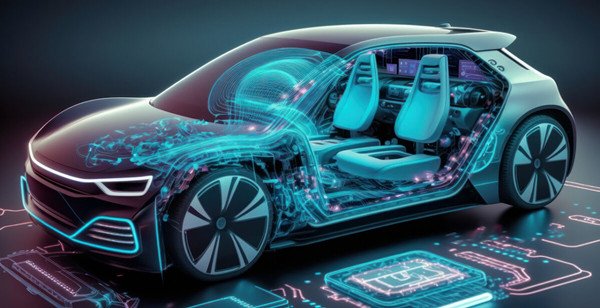Last updated on September 17th, 2024 at 05:55 pm
Nvidia’s recent statements and developments underscore the transformative potential of AI in the automotive industry, particularly in the realm of self-driving technology. Nvidia’s CFO highlighted that automotive applications are poised to become the largest enterprise vertical within their data center business this year. This is exemplified by Tesla’s significant purchase of 35,000 H100 GPUs to enhance its Full-Self Driving (FSD) system. The collaboration between Nvidia and Tesla provides a clear indication of how AI is revolutionizing self-driving technology, propelling the industry towards significant advancements.

Nvidia and Tesla
During Nvidia’s earnings call, it was revealed that Nvidia supported Tesla’s expansion of their training cluster to include 35,000 H100 GPUs. This infrastructure has been pivotal in achieving the breakthrough performance of FSD version 12, Tesla’s latest self-driving software based on vision. The use of Nvidia’s AI infrastructure has enabled the deployment of video transformers, which consume significantly more computing power but deliver dramatically improved self-driving capabilities. This technological leap has not only benefited Tesla but has also propelled significant growth for Nvidia’s AI infrastructure.
The relationship between Nvidia and Tesla is indicative of a broader trend in the automotive industry. As more companies delve into autonomous software, Nvidia expects a multi-billion dollar revenue opportunity from AI infrastructure tailored for automotive applications. This growing demand underscores the critical role of AI in shaping the future of transportation.
Self-Driving Technology
The mention of Tesla during Nvidia’s earnings call highlights the importance of self-driving software for future automotive developments. Automotive companies face a pivotal decision: either develop their own self-driving solutions or license technology from leaders like Tesla. The risk for existing automotive manufacturers is substantial. If self-driving vehicles become mainstream sooner than anticipated, companies without advanced autonomous technology will find themselves at a severe disadvantage.
Developing and deploying a car capable of utilizing Tesla’s FSD software and technology could take several years. Moreover, achieving software performance on par with Tesla’s current capabilities would require many more years of development. This lag could potentially leave traditional automakers struggling to catch up, emphasizing the need for strategic partnerships and significant investments in AI technology.
Tesla’s Dojo
Tesla is concurrently working on its own custom AI training supercomputer, known as Dojo. The goal is to create an AI training system that outperforms Nvidia’s offerings. While this is a formidable challenge, Elon Musk’s track record suggests that achieving this goal is within the realm of possibility. Should Tesla succeed in developing a more efficient and cost-effective AI training system than Nvidia’s, it would position Tesla as the most important player in self-driving software and AI. Other companies would likely prefer to use Tesla’s Dojo over Nvidia’s AI clusters.
However, the development of Dojo is a high-risk endeavor. While it has the potential to yield significant rewards, there is also a chance that it may not succeed. Nevertheless, Tesla’s history of pursuing high-risk, high-reward projects indicates that this is a risk worth taking. Beyond self-driving software for cars, Tesla is also exploring the development of humanoid robots, such as the Tesla Bot (Optimus Sub-Prime). These ambitious projects highlight Tesla’s commitment to pushing the boundaries of AI and robotics.
Nvidia’s Role in the Self-Driving Revolution
In the short term, the partnership between Tesla and Nvidia is mutually beneficial. Nvidia’s GPUs play a crucial role in the performance of Tesla’s FSD system, and this collaboration is likely to continue as long as both companies see value in it. The release of Tesla’s FSD version 12.4 will further demonstrate the advantages of using Nvidia’s GPUs, showcasing the significant progress made in self-driving technology.
Nvidia’s dominance in AI training hardware positions it as a key player in the self-driving sector. The company’s comprehensive AI infrastructure, which includes specialized computers and computing services, provides a robust foundation for developing and deploying advanced self-driving systems. As more automotive companies recognize the importance of AI, Nvidia’s market position is likely to strengthen further.
The Future Prospects of AI in Self-Driving Technology
The potential applications of AI in self-driving technology are vast and varied. From enhancing vehicle safety and efficiency to enabling fully autonomous transportation systems, AI is set to revolutionize the automotive industry. Nvidia’s ongoing innovations and strategic partnerships, such as its collaboration with Tesla, highlight the critical role of AI in this transformation.
As AI technology continues to evolve, we can expect even more sophisticated self-driving capabilities. Future advancements may include improved sensor fusion, more accurate real-time decision-making, and enhanced interaction between autonomous vehicles and their environments. These developments will not only improve the safety and reliability of self-driving vehicles but also expand their applicability across different transportation sectors.
In conclusion, Nvidia’s leadership in AI training hardware and its strategic collaboration with Tesla underscore the transformative potential of AI in self-driving technology. The ongoing innovations in AI infrastructure and the ambitious projects undertaken by companies like Tesla highlight the promising future of self-driving technology. As the automotive industry continues to embrace AI, we can anticipate significant advancements that will reshape transportation and drive the future of mobility.



